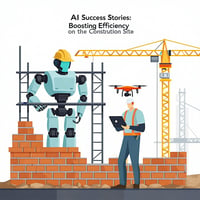Introduction Despite the historically slow pace of technological adoption in construction,...
From Reactive to Proactive: How AI is Redefining Safety Culture in Construction and Logistics
For years, health and safety (H&S) management in construction and logistics has been reactive. Incidents occur, forms are filled out, audits are conducted, and only then are corrective actions taken. But a reactive approach isn’t enough for industries under pressure from tighter regulations, labour shortages, and rising costs. AI offers a way forward – shifting safety from a compliance checkbox to a proactive, preventative culture. This article examines how AI is transforming the way companies approach safety.

The Limits of a Reactive Safety Culture
Reactive safety management may tick compliance boxes, but it rarely prevents accidents. When teams are bogged down in paperwork or scrambling before audits, they spend less time actually reducing risks.
- Delayed interventions → Problems are only addressed after incidents occur.
- Data-blind spots → Valuable insights are buried in fragmented records.
- Compliance-driven culture → Safety is seen as a burden, not as a driver of performance.
- Worker disengagement → Frontline teams lose faith in systems that feel bureaucratic rather than supportive.
How AI Enables Proactive Safety
AI transforms safety data into a strategic asset, enabling firms to identify risks early, respond quickly, and empower their workers. Instead of firefighting, managers can focus on prevention.
- Predictive Analytics for Early Intervention
AI analyses historical data to identify patterns — such as high-risk activities, times of day, or sites — where incidents are most likely to occur. - Real-Time Hazard Detection
Computer vision and sensors detect unsafe behaviour (e.g. missing PPE, unsafe machinery use) and flag it immediately. - Smarter Incident Reporting
Mobile and voice-enabled reporting tools enable workers to log issues on the spot, resulting in faster and richer data. - Proactive Compliance Checks
AI scans documents, RAMS, and certifications, flagging gaps before audits or regulators do. - Worker Empowerment
By removing admin burdens, AI gives workers and managers more time to focus on training, safety leadership, and meaningful improvements.
Benefits of a Proactive AI-Driven Safety Culture
Moving from reactive to proactive safety delivers benefits that go beyond compliance:
- Reduced accidents and downtime → Intervene before problems escalate.
- Lower insurance and legal costs → Fewer incidents mean lower premiums and reduced liability.
- Greater efficiency → Less admin frees time for high-value safety work.
- Stronger reputation → A proactive safety culture builds trust with clients, regulators, and employees.
- Employee engagement → Workers feel protected, valued, and empowered.
Conclusion
A reactive safety culture may satisfy minimum compliance, but it doesn’t build resilience. With AI, construction and logistics firms can turn safety into a proactive strategy — preventing risks, empowering workers, and protecting both people and profits.
Frequently Asked Questions
Q: What’s the difference between reactive and proactive safety culture?
Reactive safety responds to incidents after they happen. Proactive safety predicts and prevents issues before they occur.
Q: How does AI make safety culture more proactive?
AI provides predictive insights, real-time monitoring, and automated compliance, helping managers act early and focus on prevention.
Q: Isn’t AI expensive to implement?
AI adoption can start small — with mobile reporting or automated document checks — and scale as benefits are proven. ROI is typically realised within 12 months.
Q: Does proactive safety still meet compliance requirements?
Yes, in fact, it goes beyond compliance, ensuring firms are always audit-ready while reducing the risk of accidents.
Ready to shift from reactive to proactive? Solutions like LogiDocs help you embed AI into everyday safety management, so compliance and prevention work hand in hand.



